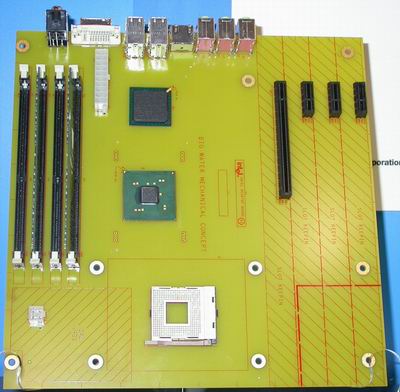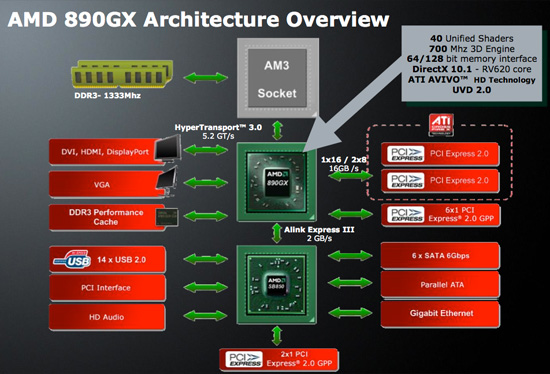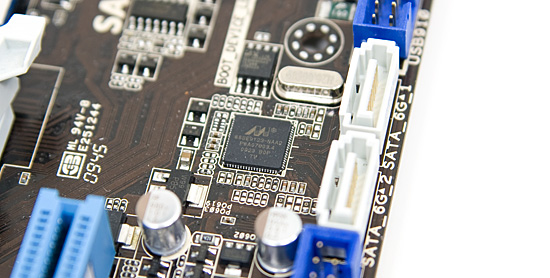6Gbps SATA Performance: AMD 890GX vs. Intel X58/P55
by Anand Lal Shimpi on March 25, 2010 12:00 AM EST- Posted in
- Storage
The Primer: PCI Express 1.0 vs. 2.0
A serial interface, PCI Express is organized into lanes. Each lane has an independent set of transmit and receive pins, and data can be sent in both directions simultaneously. And here’s where things get misleading. Bandwidth in a single direction for a single PCIe 1.0 lane (x1) is 250MB/s, but because you can send and receive 250MB/s at the same time Intel likes to state the bandwidth available to a PCIe 1.0 x1 slot as 500MB/s. While that is the total aggregate bandwidth available to a single slot, you can only reach that bandwidth figure if you’re reading and writing at the same time.

One of our first encounters with PCI Express was at IDF in 2002
PCI Express 2.0 doubles the bidirectional bandwidth per lane. Instead of 250MB/s in each direction per lane, you get 500MB/s.
Other than graphics, there haven’t been any high bandwidth consumers on the PCIe bus in desktops. Thus the distinction between PCIe 1.0 and 2.0 has never really mattered. Today, both USB 3.0 and 6Gbps SATA aim to change that. Both can easily saturate a PCIe 1.0 x1 connection.

Intel's X58 Chipset. The only PCIe 2.0 lanes come from the IOH.
This is a problem because all Intel chipsets have a combination of PCIe 1.0 and 2.0 slots. Intel’s X58 chipset for example has 36 PCIe 2.0 lanes off of the X58 IOH, plus an additional 6 PCIe 1.0 lanes off the ICH. AMD’s 7 and 8 series chipsets don’t have any PCIe 1.0 slots.

AMD's 890GX doesn't have any PCIe 1.0 lanes
No desktop chipset natively supports both 6Gbps SATA and USB 3.0. AMD’s 8-series brings native 6Gbps SATA support, but USB 3 still requires an external controller. On Intel chipsets, you need a separate controller for both 6Gbps SATA and USB 3.
These 3rd party controllers are all PCIe devices, just placed on the motherboard. NEC’s µPD720200 is exclusively used by all motherboard manufacturers for enabling USB 3.0 support. The µPD720200 has a PCIe 2.0 x1 interface and supports two USB 3.0 ports.
The USB 3 spec calls for transfer rates of up to 500MB/s. Connected to a PCIe 2.0 interface, you get 500MB/s up and down, more than enough bandwidth for the controller. However if you connect the controller to a PCIe 1.0 interface, you only get half that (and even less in practice). It’s not a problem today but eventually, with a fast enough USB 3 device, you’d run into a bottleneck.
The 6Gbps situation isn’t any better. Marvell’s 88SE91xx PCIe 2.0 controller is the only way to enable 6Gbps SATA on motherboards (other than 890GX boards) or add-in cards today.

The interface is only a single PCIe 2.0 lane. The 6Gbps SATA spec allows for up to 750MB/s of bandwidth, but the PCIe 2.0 x1 interface limits read/write speed to 500MB/s. Pair it with a PCIe 1.0 x1 interface and you’re down to 250MB/s (and much less in reality due to bus overhead).










57 Comments
View All Comments
assassin37 - Thursday, March 25, 2010 - link
why isnt the x-58 gigabyte native 6gbs board on the write benchmarks?blacksun1234 - Thursday, March 25, 2010 - link
I would like to see HD Tune & HD Tach Average Read speed with Crucial HDD for each chipset. With this benchmark, AMD SB850 can beat Marvell's solution a lot!Nickel020 - Thursday, March 25, 2010 - link
There's a small error on page 4, that's an X58A-UD3R you've got there, not an X58-UD3R.Also, there seem to be two different Marvell 6G controllers, the 88SE9123 and the 88SE9128, what's difference between these two?
Nickel020 - Thursday, March 25, 2010 - link
Finished reading, very interesteing results :)I find it really strange that P55 performs so poorly, I wonder whether it also performs poorly when used with SATA 3G SSDs, seeing as I'm just about two migrate my Vertex 60GB RAID 0 from P45&ICH10R to P55.
Would be great if you could look into that as well, better storage performance would be a major reason to buy S1366 instead of S1156.
Etern205 - Thursday, March 25, 2010 - link
If it's possible, mind adding the Asus U3S6 to your test (in a updated article) since that card uses a PCIe x4 interface.Thank You! :)
The card
http://www.newegg.com/Product/Product.aspx?Item=N8...">http://www.newegg.com/Product/Product.a...&cm_...
nerdtalker - Thursday, March 25, 2010 - link
That's an interesting card, since it appears from the photo to incorporate the 4x PCIe 1.0 PLX controller, or essentially the same on-motherboard solution ASUS was using.That seems like a much more interesting card to test.
7Enigma - Thursday, March 25, 2010 - link
Hi Anand,I have to admit that this particular article was a bit confusing for me. Probably because the test rigs are so similar in name I was going back and forth. My question is how does this article's results correlate to earlier boards (P45 for me in particular)? Am I understanding things correctly to assume that sticking a 6Gbps SATA card would actually be detrimental to performance in my rig if I was to get a new SSD in the coming months?
Thanks for the informative article.
semo - Thursday, March 25, 2010 - link
Hi Anand,On the 1st page, were you comparing Vertex LE performance on 890GX vs X58 or H55? And also do you have any comments on why it's random read is slower than the random write. AFAIK this is the only SSD with such characteristics.
Thanks
Casper42 - Thursday, March 25, 2010 - link
I noticed the same. Text says compared to X58 but both charts on page 1 say H55.Exodite - Thursday, March 25, 2010 - link
With the Thuban hexa-cores and 890X/FX boards in the pipeline AMD looks better and better for my next rig. After building a 790FX/PII 965BE rig for a friend, however, I were worried by the obviously poor disk performance even in comparison to my old P35/E6600 setup with an older HDD.I appreciate being kept up to date with this development as I see disk performance as the only major drawback of the platform at this point.